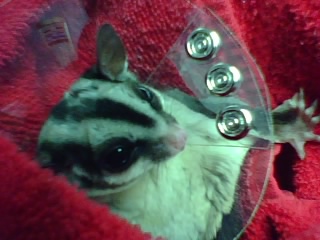AMPUTATION AFTER-CARE INSTRUCTIONS
Contributed by Kate Keller
Amputations – especially of the tail or one leg - are one of the most common surgical procedures in sugar gliders. In most cases, the glider will be able to live out a normal, active life once healing is complete.
There are a few steps to take to help you and your glider through this healing phase:
•
Pain Control: This is extremely important. Be sure you are given enough pain medication to last for 7-10 days. Gliders in pain will often lick or chew at the area which can cause complications.
•
Other Medications: Be sure to dispense any oral antibiotics or topical medications as instructed by your veterinarian.
•
E-collar: If the surgery site is accessible to the glider (for example, the tail or foot), place them in an e-collar to prevent access to the area. Cage and feeding will have to be modified while the glider is in the e-collar, and you may have to help the glider groom itself.
•
Isolate: Keep your glider in a separate cage during healing. Cage mates will often groom each other and this can inadvertently cause complications or pain.
•
Hygiene: The site must be kept clean and dry. Do not cover the area with any type of bandage or material. This will hold in moisture and can cause complications and/or delay healing. Also, be sure to keep the cage clean at all times.
•
Minimize Stress: Physical and emotional stress will impede the healing process. Be observant of changes in behavior, provide adequate enrichment items and spend extra one-on-one time with them while they’re away from their cage mates.
•
Allow time to heal: ESPECIALLY rest time. Do not disturb your glider’s sleep multiple times each day just to check on him/her. Allow them to rest and keep them in a hospital cage.
•
Follow up with Vet: It is extremely important that you keep any follow-up appointments for re-check with your vet.
Be sure to familiarize yourself with how the area looks after surgery. While appearance will change as healing progresses, you’ll want to call your vet if you notice any abnormal coloring or symptoms. Be especially observant of the area adjacent to the surgery site. If you notice the area turning black or looking dry, contact your vet immediately as these can be signs of necrosis. Necrosis is dead or dying tissue and will need to be tended to by a vet ASAP.
Dealing with an injured or recovering glider can be extremely stressful on both animal and owner. Although it may be difficult following the above suggestions, it will increase the chances of successful and speedy healing.
